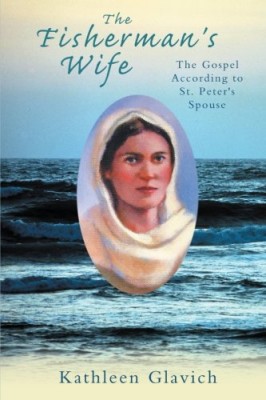Do you enjoy historical fiction? Are you fascinated with life “back in the day” and find it interesting to learn more about the ins and outs of daily living in a particular time period? More specifically, do you ever feel like you wish you knew a bit more about some of your favorite Biblical characters, even those who are nameless?

If you answered “yes” to any of the above questions, you might consider picking up a copy of The Fisherman’s Wife by Kathleen Glavich. The Fisherman’s Wife includes all of your favorite Bible stories from the perspective of Miriam, St. Peter’s wife.
While, historically, we do not know the real name of St. Peter’s wife, Glavich gives the heroine of her novel the Hebrew name of Miriam. And while we do not know much about her in general, we do know that Peter was married at one point in his life, for Jesus healed his mother-in-law in Luke 4:38-40. Different theories speculate that Peter’s wife died prior to this healing, but according to Glavich, “adopting that theory would have resulted in a very short book indeed!” So, she relies more on the writings of Clement of Alexandria who believes St. Peter’s wife suffered martyrdom. Excavations of bones near those of St. Peter are said to be of an old woman. Could they be those of his wife? We do not know for certain.
The Fisherman’s Wife opens with Miriam as a girl, and within a few chapters, she reaches the marrying age and meets Simon. Their courtship and early years of marriage are described as joyful, and they soon start a family and begin focusing their energy on raising their children. Some of their close relatives and neighbors also are future disciples, and Glavich develops the characters and their relationships very well.
When Peter and some of his company go to seek out John the Baptist, they discover Jesus instead, and from that moment on, the life of Peter and his wife is forever changed. Peter begins to follow Jesus without reserve. According to the Gospels, this means he left his job as a fisherman to be an apostle, but according to Glavich’s book, it also means that Peter left his wife, children and home, too.
In The Fisherman’s Wife, I really enjoy reading about the lives of Peter, his wife, their family and their friends. I like learning about what life was really like in first-century Palestine. But when Peter starts to leave for months at a time and even longer (up to 18 months, when the early Church is forming after the death and resurrection of Jesus), it begins to be a little difficult for me to believe that it really happened this way. What did Miriam and her children do for money and food? Were they safe without Peter around? How were they treated by other Galileans, who knew Peter left his family to follow Jesus?
Even when Jesus addresses Miriam directly, saying, “I have great need of Peter ... I want you to know that I understand the pain and hardship his absence will cause you ...” I am not 100% confident that Jesus would have asked married men to leave their families to follow Him. But then again, we just don’t know for sure. And the Lord does say, “ ... my thoughts are not your thoughts, nor are your ways my ways” (Isaiah 55:8).
Regardless of my uncertainty of this aspect of the book, what I really appreciate about The Fisherman’s Wife is reading all of my favorite Bible stories from the perspective of the different characters. Whether it is recounting a healing that takes place right before their eyes, or when Peter tells Miriam about his experience walking on water and then falling into the sea when he takes his eyes off of Jesus, or when Miriam’s brother tells her about Lazarus being raised from the dead, or Miriam’s own account of the crucifixion, reading these familiar tales in a narrative form brings new life to them that is truly refreshing.
I also appreciate walking with these early Christians as they slowly began to believe that Jesus truly is the Messiah. For example, when they first hear Jesus say that He is “the living bread from heaven. Whoever eats this bread will live forever,” they are bewildered by this. They aren’t sure what He really means. Some people reject this teaching completely, while others trust that in time they will understand what He means. Of course, Peter’s faith is the strongest of the many characters in The Fisherman’s Wife, and he responds to the Bread of Life discourse in this way: “At this point, I’d trust Jesus with my life. I don’t always understand what he does or says. This last teaching about food is a total mystery to me. Maybe it will come clear in time. We just have to have faith.” And Miriam responds by thinking, “Peter’s attitude is a comfort to me.”
And isn’t Peter’s attitude a comfort to us, too? For will we ever fully understand (this side of Heaven) everything that Jesus and His Church teaches? But like Miriam, we can find comfort in the faith of great saints who show us how to follow Jesus no matter what.
Above all, The Fisherman’s Wife does a wonderful job of reminding readers of the amazing life of Jesus Christ and His first followers. Our Messiah chose 12 men to begin His Church, and these men and the other early disciples sacrificed so much to spread the Gospel, even their own lives! My own faith always has opportunity to grow and be strengthened by reading Sacred Scripture and learning from the saints who have gone before me. And The Fisherman’s Wife is a wonderful book that ultimately aids in helping us to grow in our own commitment to follow the Lord as closely as possible.
Be sure to check out our Book Notes archive.
Copyright 2014, Sarah Damm
About the Author

Sarah Damm
Sarah Damm is a Catholic wife and mother of six children, living in Minnesota. She spends her days running errands, helping with homework, and keeping up with laundry and the family schedule. Sarah loves her faith, coffee, and good books. You can find out more about her at SarahDamm.com.



.png?width=1806&height=731&name=CatholicMom_hcfm_logo1_pos_871c_2728c%20(002).png)
Comments